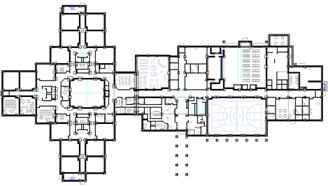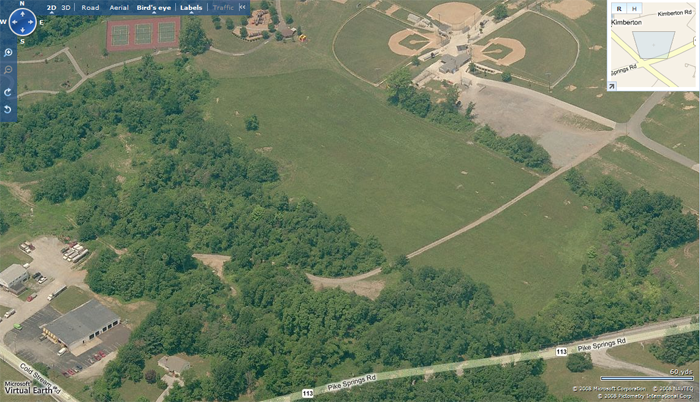
Building Name:
Kimberton Elementary School
Location and Site:
Off of Route 113 and near Cold Stream Road, near Kimberton, PA
East Pikeland Township, Chester County, Pennsylvania
Project is located next to the Kimberton fire hall and Fairgrounds. It is also located across cold stream road from the existing Kimberton superfund site
View Larger Map
Occupant:
Phoenixville Area School District. The elementary school was to replace the existing East Pikeland Elementary School. Immediately after it was complete it was to house the middle school students of Phoenixville area middle school during the renovation project of the middle school.
Function:
Elementary School for students kindergarten through fifth grade.
Size:
Overall size of the building was to be 104,000 Sq Ft of new construction on a 19.67 acre site.
Stories:
Total number of stories was to be two. The structure was to contain no basement or sub grade stories. The highest point of the building was proposed at about 30 feet above final grade.
Project Team:
Owner:
Phoenixville Area School District
Architect:
Gilbert Architects Inc.
Construction Manager:
Foreman Program and Construction Managers
Site Engineer:
CMX Engineering
Structural Engineer:
Baker, Ingram, & associates

Mechanical/Plumbing/Sprinkler/Electrical Engineer:
Snyder Hoffman & Associates
Food Service Engineer:
Glenn B. Bush and Associates 
Low Bid Contractors Proposed Contractors:
General Contractor: Miller Bros
Roofing Contractor: JM Young & Sons
Window Contractor: Glass Erectors
Drywall Contractor: All Wall & Ceiling
Carpet Contractor: DeGol Carpet
Paint Contractor: Thomas Painting
Display Contractor: Thoma Inc
Food Service Contractor: Clark Food Service
Casework Contractor: PolyVision
Plumbing Contractor: Frey Lutz Plumbing
Fire Protection Contractor: Wayman Fire Protection
HVAC Contractor: Frey Lutz Mechanical
Electrical Contractor: Silas Bolef Electrical
Data Contractor: Atlantic Coast Communications
Construction Period Proposed:
Proposed Start: July 2008
Proposed Completion: January 2010
Construction Cost:
Building construction of low bidders was 25.5 million dollars.
Note: This is the building cost only does not include and site costs, architecture, engineering, or construction management.
Project Delivery method:
Design-Bid-Build with multiple prime contracts overseen by a Construction Management agency.
Architecture:
 Design and Functional Components:
Design and Functional Components:
Kimberton Elementary School was designed to house 600 students from the Phoenixville Area School District. It was designed to replace the aging East Pikeland Elementary School. The elementary school can be divided into two main wings: the classroom wing and activities wing. The classroom wing is a two story wing while the rest of the building contains only one story.
The Classroom section or East Wing contains 30 classrooms each being about each about 750 sq ft. The classroom wing also contains 5 sets of gang bathrooms for the students to use. There are also various other rooms that can be used for small groups, Speech, Reading, and Faculty Workrooms. On the second floor of this wing is a computer lab as well as several special education classrooms. Across the hall from the computer lab is a large mechanical room. This wing contains various other support rooms (i.e. janitor’s closets, etc)
The activities wing contains your rooms such as libraries, gym and cafeteria. Inside the main entrance, which is in the activities wing, the school administration and nurse offices are located. The 3000 sq ft media center is located next to a second computer lab. The Choral and Instrumental Room is located behind the stage to provide easy access for performances. The cafeteria also doubles as a 650 seat auditorium during these performances. The school also contains a 6000 S.F. Gymnasium with a full basketball and volleyball court. There is also an art and health classroom located in this wing. Across the hall from these rooms is the main mechanical room as well a faculty dining room. This wing also contains various other support rooms.
Major National Model Codes:
Building Code: 2003 International Building Code
Mechanical Code: 2003 International Mechanical Code
Plumbing Code: 2003 International Plumbing Code
Electrical Code: 2003 International Electrical Code
Fire Code: 2003 International Fire Code
Energy Code: 2003 IECC w/ 2001 supplement to iecc/ASHAE 90.1-1999
Fuel Gas Code: 2003 International Fuel Gas Code
A.D.A.: ICC/ANSI 117.1, 1998
Zoning:
Original Zoning: Kimberton Retail
Proposed Use: School (permited by East Pikeland Township)
Permits obtained from East Pikeland Township
Historical Requirements:
None
Building Envelope:
The building has four major exterior wall types. On the first floor the majority of the wall is a masonry veneer on CMU. The first floor also has a forest green cementitious siding which is used as an accent. The masonry veneer has four different types of finish that is used at various location throughout the building. A darker split face block is used above ground level. Above the split face block on a number of facades is a tan sand blasted CMU veneer. The different facades are transitioned between by a ground face almost white CMU veneer. Second floor contains mostly green cementitious siding on 6” metal studs with a few examples of a masonry veneer on metal studs around the stairwells.

The roof is made up of two different types. On the higher roof (above a normal single story) the roof is sloped. This roof has asphalt shingles on top of vented roof insulation which is installed in two layers. This is held up by a metal roof deck which supported by various different steel joists. The single high roof is single-ply roofing membrane (a white roof was chosen as an alternate) and insulated by Tapered insulation and 3” of rigid insulation. This again is supported by a metal roof deck on top of steel joists.



Primary Engineering Systems:
Construction:
The project is being delivered using a design-bid-build method with multiple prime contracts and a construction management agency overseeing. The contracts are divided into 15 prime contracts: General Construction, Roofing Construction, Aluminum Entrances and Windows Construction, Ceramic and Quarry Tile Construction, Acoustical and Drywall Construction, Resilient Flooring and Carpeting, Painting Construction, Visual Display Construction, Food Service Equipment Construction, General Casework Construction, Plumbing Construction, Fire Protection Construction, HVAC Construction, Electrical Construction, Data Cabling Construction. Each Contract is held by the owner (Phoenixville Area School District). The construction manager will run the day to day management of the project and the school will release the payments.
The multiple prime delivery method of project delivery was chosen because of a Pennsylvania State requirement for school construction. PA requires a multiple prime delivery method for school projects. In most cases, this requirement creates the need for a construction manager on the project because most schools do not have the ability to manage large construction projects with their own personnel.
The architect, Gilbert, was chosen by the school administration and approved by the school board. The architect’s contract amount is based upon a percentage of the project cost.
The Construction Manager, Foreman Program and Construction Managers, was chosen in much of the same manner as the architect. Foreman has developed a relationship with Phoenixville Area School District on a previous project and the school board approved awarding Foreman the construction management contract at the administration’s suggestion.
All the prime contracts were selected as using public bid. The low bid contractor was selected by law and the school board was to award the contracts. Each contractor is responsible for their own bonds and insurance in most cases. Each contractor is responsible for showing proof of a Bid Bond, Performance Bond, and Payment Bond.
The insurance for this project is a little more complicated than the bonds. All parties are responsible for having their own worker’s compensation insurance, employer’s liability insurance, and unemployment insurance. For the project, the owner will purchase all-risk insurance, fire and extended coverage insurance, owner’s liability, property insurance, loss of use insurance, and boiler and machinery insurance. Each prime contractor is responsible for purchasing its own contractor’s liability insurance, contractual liability insurance, public liability, comprehensive automobile insurance, product and operations insurance, stored materials, and environmental (population) liability(for those contractors who are performing site work. The construction manager and architect have relatively no insurance to purchase.
Electrical:
The elementary school gets its power from electrical lines under the nearby cold stream road. The power is stepped down from 33KV to 480/277V in a PECO transformer outside the building. The lines then run underground into the main electrical room and main switchboard which is in the southwest corner (plan east) of the building. The power is distributed throughout the building at 480V/277V and is stepped down to 120/208V using 5 transformers. One main transformer is located in the main mechanical room while the other main transformer is located in an electrical closet in the classroom wing. Most of the lighting is powered by 277V and is not stepped down from the PECO supplied power. There are 40 panel boards throughout the building to power the lighting, receptacles and various types of equipment.
The emergency circuit is power by a 125 KW backup generator that serves only a single light from each classroom and various lights throughout the corridors. There are also three other panel boards powered by the emergency generator. These panel boards power all the refrigeration units, emergency systems (fire, security, intercom, and telephones), and various receptacles throughout the building.
Lighting:
There are 59 different types of light fixtures used in Kimberton Elementary School of which all but 6 are powered by 277V. The classrooms are lit by a 2x4 recessed light with .125” acrylic lens. Each light has three 32W T8 lamps at CCT of 4100K. Each classroom is switched to allow for three lighting levels: One lamp, two lamps, or three lamps in each fixture. And also use tandem wired from fixture to fixture to allow for less ballast use. The hallways use the same Columbia fixture as the classrooms with about every other light being on the emergency circuit. The media center uses a combination of 12’ and 8’ pendent lighting that hanging 24” below the ceiling. Each pendent light has 32W T8 lamps at CCT of 4100K. Use of this consistent lamp type allows the maintain of Kimberton to have less different lamp types that they have to purchase. 8” diameter fluorescent down lights are above the reading area of the media center. Overtop of the receptionist desk are pendent track lights. The gymnasium is lit by 24 4-lamp high bay fluorescent lights manufactured by Williams. The cafeteria contains 25 2x2 dimmable 150W metal halide lights. The stage has theatrical lighting.
Mechanical:
The mechanical system of Kimberton was originally proposed as a geothermal heat pump system. This was scratched however because of contaminated groundwater under the site and contaminated soil in the northwest corner. The system was instead changed to a water source heat pump. Each room is served by its own water source heat pump which average about CFM of 1200 to 690 and having a cooling capacity of on average of 26 MBH. The media center has its own roof top unit which has a 3000 CFM, 82 MBH cooling and 80 MBH heating capacity. Most of the classroom heat pumps are housed in the second floor mechanical room. These individual heat pumps allow for localized temperature setting without the need for reheat which increase efficiency.
6 water source heat recovery units are on top of the roof to provide cooling and heating for the 104,000 sq ft building. The Des Champs manufactured classroom HRUs provide a total of 761 MBH cooling, 457 MBH heating, and about 20,000 CFM and are housed on the mechanical mezzanine. The remaining 4 HRUs serve the activities wing of the building are above the cafeteria and have a 706 MBH cooling, 424 MBH heating and 18,000 CFM. The heat recovery units supply all of the outside air to the individual heat pumps. Each heat recovery unit has an energy wheel to help the efficiency of the entire HVAC system. The system is dependent on two boilers and single cooling tower
The heating and cooling for the building is distributed almost 100% all air from the individual heat pumps and roof top units. Each unit is also connected to a cold water supply and return from the main cooling tower. The mechanical rooms are located in the southwest corner of the building as well as on the eastern second floor.
Structural:
The structural system for Kimberton Elementary School is structural steel. The floor system is a 1.5 inch 20 gauge composite deck with 2.5 inches of normal weight concrete topping. The deck concrete is reinforced with 6x6-W2.1xW2.1 WWF. The total floor thickness is 4 inches. The roof is also covered by 1.5 inches of 20 gauge type B steel deck which it protected from the weather by either asphalt shingles or a single ply membrane. The steel members supporting the 40 pounds per square foot live load of the classrooms are W18x40 steel I beams spanning approximately 32 feet at a 5.5 foot spacing. W27x84’s support the multi-room classrooms which span 50 feet at a 5 foot spacing. Most of the roof is supported by K-series joists. Non-standard Gable Shaped LH Joists span the 54 feet over the media center. Over the cafeteria 44LH15 joist span 72 feet. The gym roof is supported by custom designed gable trusses that span 64 feet. These trusses are cross-braced with W8x15. The majority of the steel structure is supported by HSS8x8x1/4 columns. The corners contain HSS8x8x1/2 columns. At various locations throughout the building there are HSS12x8x5/8 columns. W8x24 columns support the wood trusses of the main entrance canopy also well as various other entry roofs around the building.
Spread footing support the steel structure. Most footing range from 4x4 to 10x10 and have a depth from 1 foot to 2.333 feet. The exterior wall are supported by a foundation wall that is 1 foot deep at most locations through out the building. A 4” cast in place concrete slab with 6x6 W2.9xW2.9 WWF on 4” of drainage fill and a high grade vapor barrier is used as the ground floor on most of the building.
Additional Engineering and Engineering Support Systems:
Fire Protection:
Kimberton Elementary has an active automated fire extinguishing system and smoked detectors throughout the building. The building is equipment with audio/visual fire alarms in every classroom, gymnasium, cafeteria, etc. and all corridors. The school contains only quick response rated heads that have a maximum coverage of 130 ft. Each Classroom contains nine concealed pendent heads and the concealed hallway heads are place about every twelve feet. Various other types of heads are throughout the larger assembly areas.
There are very few fire walls around located in Kimberton Elementary. There is a major two hour fire rated wall between the classroom wing and activities wing. The walls around the stairwells have a one hour fire rating. The elevator is also required to have one hour fire rating. Around the electrical, storage, and vertical shaft there is a smoke partitions. All fire walls are required to go from floor to deck.
This page was last updated on Wednesday, September 2, 2009 , by Ralph Kreider and is hosted by the AE Department ©2009
